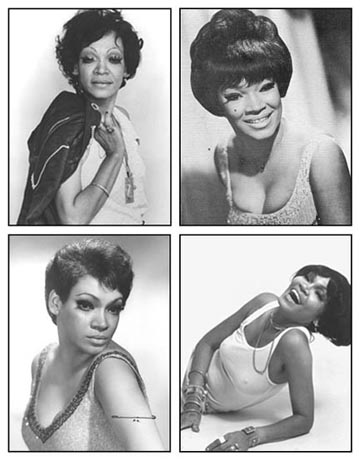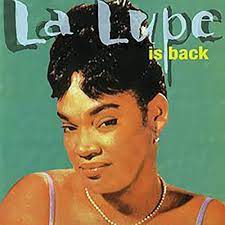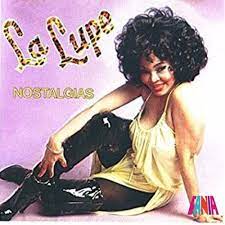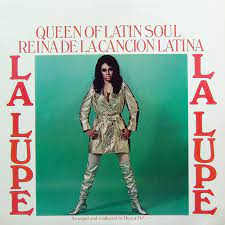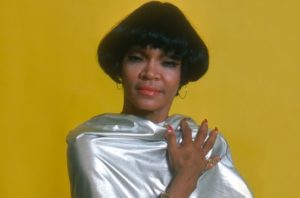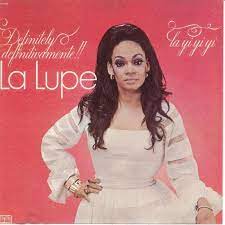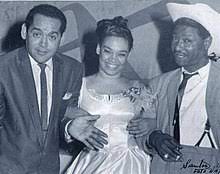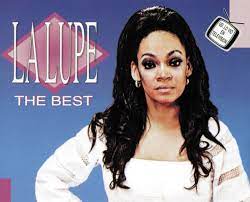LA LUPE, LATIN SOUL SINGER KNOWN FOR HER ENERGETIC, SOMETIMES CONTROVERSIAL PERFORMANCES. VIDEOS
Guadalupe Victoria Yolí Raymond, better known as La Lupe was born in the barrio of San Pedrito in Santiago de Cuba on December 23, 1936. She was a Cuban singer of boleros, guarachas, and Latin soul, known for her energetic, sometimes controversial performances.
Following the release of her first album in 1961, La Lupe moved from Havana to New York and signed with Tico Records, which marked the beginning of a prolific and successful career in the 1960s and 1970s. She retired in the 1980s due to religious reasons.
Her father was a worker at the local Bacardí distillery and a major influence on her early life. In 1954 she participated in a radio program that invited fans to sing imitations of their favorite stars. Lupe escaped from school to sing a bolero of Olga Guillot’s, called “Miénteme” (Lie to Me) and won the competition. The family moved to Havana in 1955, where she was enrolled at the University of Havana to become a teacher. She admired Celia Cruz and like her, she graduated from teaching instruction before starting her professional singing career.
https://youtu.be/R-CpdAtgKQY
LA LUPE SINGS “PURO TEATRO” (VIDEOS)
Lupe married in 1958 and formed a musical trio with her husband Eulogio “Yoyo” Reyes and another female singer. This group, Los Tropicuba, broke up along with her marriage in 1960. She began to perform her own act at a small nightclub in Havana, La Red (The Net), which had a clientele of distinguished foreigners. She acquired a devoted following, which included Ernest Hemingway, Tennessee Williams, Jean-Paul Sartre, Simone de Beauvoir, and Marlon Brando. She recorded her first album, Con el diablo en el Cuerpo, in 1960 for Discuba, the Cuban subsidiary of RCA Victor. On the album, she was backed by two different groups directed by Felipe Dulzaides and Eddy Gaytán. Her first television appearance on Puerto Rican television caused a stir due to her frenzied, vibrant performance, which reportedly shocked some viewers.
EXILE AND SUCCESS
In 1962 she was exiled to México. She approached Celia Cruz and asked for her support to get work, and in turn, Celia recommended her to Mongo Santamaría in New York. In New York City, Lupe performed at a cabaret named La Berraca and started a new career, making more than 10 records in five years. She married a second time, to salsa musician Willie García, with whom she had a son. That marriage also ended in divorce.
Lupe’s passionate performances covered the range of music: son montuno, bolero, boogaloo, venturing into other Caribbean styles like Dominican merengue, Puerto Rican bomba, and plena. It was her recordings that brought Tite Curet Alonso into prominence as a composer of tough-minded boleros in the salsa style. For a good part of the 1960s, she was the most acclaimed Latin singer in New York City due to her partnership with Tito Puente. She did a wide variety of cover versions in either Spanish or accented English, including “Yesterday”, “Dominique” by The Singing Nun, “Twist & Shout”, “Unchained Melody”, “Fever” and “America” from West Side Story. Fred Weinberg, who was her favorite audio engineer, and also worked with Celia Cruz, Mongo Santamaria, Tito Puente, and many more of the Latin American greats, and a producer on several of Lupe’s albums, called La Lupe “A talent hurricane” in the studio due to her intense singing and enthusiasm.
The quality of her performances became increasingly inconsistent. There were persistent rumors of her drug addiction and her life was “a real earthquake” according to statements of close friends, although Fred Weinberg, who engineered, and also produced a vast amount of her albums, stated that “In all the years I worked with Lupe, not once did I ever see her on drugs, or using drugs…Heck, she never even drank liquor due to her strong belief in religion.” She ended some of her on-stage engagements being treated with an oxygen mask. Although she may have been poorly managed by her label Fania Records, in particular, she managed and produced herself in mid-career, after she parted ways with Tito Puente. However, in the late 1960s, her ephemeral career went downhill. The explosion of salsa and the arrival of Celia Cruz to New York were the determining factors that sent her into the background and her career declined thereafter.
https://youtu.be/SFrMoECK1U8
LA LUPE SINGS (VIDEOS)
LATER YEARS AND DEATH
A devout follower of Santería, she continued to practice her religion. Her record label Fania Records (which had previously acquired Tico) ended her contract in the late 1970s, perhaps simply because of her falling record sales. She retired in 1980 and found herself destitute by the early 1980s. In 1984 she injured her spine while trying to hang a curtain in her home; she initially used a wheelchair, then later a cane. An electrical fire made her homeless. After being healed at an evangelical Christian crusade, La Lupe abandoned her Santería roots and became a born-again Christian. In 1991, she gave a concert at La Sinagoga in New York, singing Christian songs.
La Lupe died on February 29, 1992, of a heart attack at the age of 55 and is buried in Saint Raymond’s Cemetery in the Bronx.
DISCOGRAPHY
Albums
Con el diablo en el cuerpo (1960, Discuba)
La Lupe is back 1961
Mongo Introduces La Lupe 1963
Tito Puente Swings, The Exciting Lupe Sings 1965 (with Tito Puente)
Tú y yo 1965 (with Tito Puente)
Homenaje a Rafael Hernández 1966 (with Tito Puente)
La Lupe y su alma venezolana 1966
A mí me llaman La Lupe 1966
The King and I 1967 (with Tito Puente)
The Queen does her own thing 1967
Two Sides of La Lupe 1968
Queen of Latin Soul 1968
La Lupe’s era 1968
La Lupe is the Queen 1969
Definitely La Yi Yi Yi 1969
That genius called the Queen 1970
La Lupe en Madrid 1971
Stop, I’m free again 1972
¿Pero cómo va ser? 1973
Un encuentro con La Lupe – with Curet Alonso 1974
One of a kind 1977
La pareja 1978 (with Tito Puente)
En algo nuevo 1980
SELECTIONS OF HER PERFORMANCES
Lo mejor de la Lupe Compilation, 1974
Apasionada Compilation, 1978
La Lupe: too much 1989. Compilation from Tico recordings only, by Charly Records LP HOT 123
Dance with the Queen 2008
La Lupe greatest hits 2008
HIT SINGES
“Con el diablo en el cuerpo”
“Fiebre”
“Crazy heart”
“Qué te pedí?”
“La tirana” [Tico SLP 1167]
“Puro teatro” [Tico SLP 1192]
“Adiós”
“Carcajada final” [Tico SLP 1176]
“A Benny Moré [Tico CLP 1310]
FILM AND THEATER
La gran tirana by Carlos Padrón-Cuba. 2011 Havanna, 2012: Havanna at Humboldt Haus, Ulm at theater in der westentasche, Theater Tage in Karlsruhe, Kubanische Botschaft in Berlin. Starring: Nancy Calero-Germany.
La Lupe: my life, my destiny: theatrical production by Carmen Rivera (2001)
La Lupe: Queen of Latin Soul film by Ela Troyano (2003; 2007)
La Reina, La Lupe by Rafael Albertori (2003)
IN POPULAR CULTURE
– Her recording of La Virgen Lloraba was used in the 1996 film The Birdcage.
– In 2002, New York City renamed East 140th Street in The Bronx as La Lupe Way in her memory.
– Cuban-American writer Daína Chaviano pays homage to La Lupe in the novel The Island of Eternal Love (Riverhead-Penguin, 2008), where the singer appears in a cameo singing Puro Teatro.
– On the TV series RuPaul’s Drag Race: All-Stars, Puerto Rican drag queen Nina Flowers chose to impersonate La Lupe.
– Her recording of “Fever” was included in the episode “Angels of Death,” from season two of the Starz series Magic City.
– A poem by Víctor Hernández Cruz was written about her: La Lupe.
– In 1991, comedian Sandra Bernhard released a track called “La Lupe” on her album Excuses for Bad Behavior, Part #1, speaking in Spanish and English, in which Bernhard briefly speaks of the dissolution of the La Lupe/Tito Puente relationship.
– In 2015, an analogous and fictionalized version of La Lupe (renamed Lola Calvo for the series), was heavily featured in an 80 episode Spanish-language biographical television series of Celia Cruz called Celia, on the Telemundo network.
– In 2017, the first episode of TNT’s Claws is titled “Tirana” and in it, the main characters lip-sync and dance to one of La Lupe’s signature songs.
– In 2002, her song “Que te Pedí” was featured in the film Empire.
– La Lupe’s signature song, “Que te Pedí”, was featured in the 2006 film, El Cantante, starring Marc Anthony as Hector Lavoe.
– In 2020, the Colombian singer Kali Uchis, added a cover of “Que te pedi” in her album Sin Miedo (Del amor y otros demonios)
LA LUPE, CANTANTE DE LATIN SOUL CONOCIDA POR SUS ACTUACIONES ENERGÉTICAS, A VECES CONTROVERSALES. VIDEOS
Guadalupe Victoria Yolí Raymond, más conocida como La Lupe nació en el barrio de San Pedrito en Santiago de Cuba el 23 de diciembre de 1936. Fue una cantante cubana de boleros, guarachas y soul latino, conocida por sus enérgicas, a veces controvertidas interpretaciones. .
Tras el lanzamiento de su primer álbum en 1961, La Lupe se mudó de La Habana a Nueva York y firmó con Tico Records, lo que marcó el comienzo de una carrera prolífica y exitosa en las décadas de 1960 y 1970. Se retiró en la década de 1980 por motivos religiosos.
Su padre era un trabajador de la destilería local Bacardí y una gran influencia en sus primeros años de vida. En 1954 participó en un programa de radio que invitaba a los fanáticos a cantar imitaciones de sus estrellas favoritas. Lupe escapó de la escuela para cantar un bolero de Olga Guillot, llamado “Miénteme” (Lie to Me) y ganó el concurso. La familia se mudó a La Habana en 1955, donde se matriculó en la Universidad de La Habana para convertirse en maestra. Admiraba a Celia Cruz y, como ella, se graduó de la docencia antes de comenzar su carrera profesional como cantante.
https://youtu.be/iiYn0UGv8qQ
LA LUPE CANTA “PURO TEATRO” (VIDEOS)
Lupe se casó en 1958 y formó un trío musical con su esposo Eulogio “Yoyo” Reyes y otra cantante. Este grupo, Los Tropicuba, se disolvió junto con su matrimonio en 1960. Comenzó a realizar su propio acto en una pequeña discoteca de La Habana, La Red, que contaba con una clientela de distinguidos extranjeros. Adquirió seguidores devotos, que incluían a Ernest Hemingway, Tennessee Williams, Jean-Paul Sartre, Simone de Beauvoir y Marlon Brando. Grabó su primer álbum, Con el diablo en el Cuerpo, en 1960 para Discuba, la filial cubana de RCA Victor. En el álbum, estuvo respaldada por dos grupos diferentes dirigidos por Felipe Dulzaides y Eddy Gaytán. Su primera aparición en televisión en la televisión puertorriqueña causó revuelo debido a su actuación frenética y vibrante, que supuestamente sorprendió a algunos espectadores.
EXILIO Y ÉXITO
En 1962 se exilia a México. Se acercó a Celia Cruz y le pidió su apoyo para conseguir trabajo, y a su vez, Celia la recomendó a Mongo Santamaría en Nueva York. En la ciudad de Nueva York, Lupe actuó en un cabaret llamado La Berraca y comenzó una nueva carrera, haciendo más de 10 discos en cinco años. Se casó por segunda vez con el salsero Willie García, con quien tuvo un hijo. Ese matrimonio también terminó en divorcio.
Las apasionadas actuaciones de Lupe cubrieron la gama de música: son montuno, bolero, boogaloo, incursionando en otros estilos caribeños como el merengue dominicano, la bomba puertorriqueña y la plena. Fueron sus grabaciones las que llevaron a Tite Curet Alonso a la prominencia como compositora de boleros duros de estilo salsa. Durante buena parte de la década de 1960, fue la cantante latina más aclamada en la ciudad de Nueva York debido a su asociación con Tito Puente. Hizo una amplia variedad de versiones en español o en inglés con acento, incluidos “Yesterday”, “Dominique” de The Singing Nun, “Twist & Shout”, “Unchained Melody”, “Fever” y “America” de West Side Story. . Fred Weinberg, quien era su ingeniero de audio favorito, y también trabajó con Celia Cruz, Mongo Santamaria, Tito Puente y muchos más de los grandes latinoamericanos, y productor de varios de los álbumes de Lupe, llamado La Lupe “Un huracán de talentos” en el estudio debido a su intenso canto y entusiasmo.
https://youtu.be/oJy3lQoSnEA
LA LUPE CANTA (VIDEOS)
La calidad de sus actuaciones se volvió cada vez más inconsistente. Hubo rumores persistentes de su adicción a las drogas y su vida fue “un verdadero terremoto” según declaraciones de amigos cercanos, aunque Fred Weinberg, quien diseñó y también produjo una gran cantidad de sus álbumes, afirmó que “en todos los años que trabajé con Lupe, ni una sola vez la vi drogarse o consumir drogas … Diablos, ni siquiera bebió licor debido a su fuerte creencia en la religión “. Terminó algunos de sus compromisos en el escenario siendo tratados con una máscara de oxígeno. Aunque pudo haber sido mal administrada por su sello Fania Records, en particular, se las arregló y se produjo a sí misma a mitad de su carrera, después de separarse de Tito Puente. Sin embargo, a finales de la década de 1960, su efímera carrera fue cuesta abajo. La explosión de la salsa y la llegada de Celia Cruz a Nueva York fueron los factores determinantes que la enviaron a un segundo plano y su carrera decayó a partir de entonces.
AÑOS DESPUES Y SU MUERTE
Una devota seguidora de la Santería, continuó practicando su religión. Su sello discográfico Fania Records (que previamente había adquirido Tico) terminó su contrato a fines de la década de 1970, quizás simplemente debido a la caída de sus ventas de discos. Se jubiló en 1980 y se encontró en la indigencia a principios de la década de 1980. En 1984 se lesionó la columna vertebral al intentar colgar una cortina en su casa; inicialmente usó una silla de ruedas, luego un bastón. Un incendio eléctrico la dejó sin hogar. Después de ser sanada en una cruzada cristiana evangélica, La Lupe abandonó sus raíces de santería y se convirtió en una cristiana renacida. En 1991, dio un concierto en La Sinagoga de Nueva York, cantando canciones cristianas.
La Lupe murió el 29 de febrero de 1992 de un infarto a la edad de 55 años y está enterrada en el cementerio de Saint Raymond en el Bronx.
DISCOGRAFÍA
Álbumes
Con el diablo en el cuerpo (1960, Discuba)
Vuelve La Lupe 1961
Mongo presenta La Lupe 1963
Tito Puente Swings, The Exciting Lupe Sings 1965 (con Tito Puente)
Tú y yo 1965 (con Tito Puente)
Homenaje a Rafael Hernández 1966 (con Tito Puente)
La Lupe y su alma venezolana 1966
A mí me llaman La Lupe 1966
El Rey y yo 1967 (con Tito Puente)
La reina hace lo suyo 1967
Dos caras de La Lupe 1968
Reina del Soul Latino 1968
Era de la Lupe 1968
La Lupe es la Reina 1969
Definitivamente La Yi Yi Yi 1969
Ese genio llamado Reina 1970
La Lupe en Madrid 1971
Detente, soy libre de nuevo 1972
¿Pero cómo va ser? 1973
Un encuentro con La Lupe – con Curet Alonso 1974
Único en 1977
La pareja 1978 (con Tito Puente)
En algo nuevo 1980
SELECCIONES DE SUS ACTUACIONES
Compilación Lo mejor de la Lupe, 1974
Compilación Apasionada, 1978
La Lupe: too much 1989. Recopilación de grabaciones de Tico únicamente, por Charly Records LP HOT 123
Baila con la reina 2008
Grandes éxitos de La Lupe 2008
HIT SINGLES
“Con el diablo en el cuerpo”
“Fiebre”
“Corazón Loco”
“¿Qué te pedí?”
“La tirana” [Tico SLP 1167]
“Puro teatro” [Tico SLP 1192]
“Adiós”
“Carcajada final” [Tico SLP 1176]
“A Benny Moré [Tico CLP 1310]
CINE Y TEATRO
La gran tirana de Carlos Padrón-Cuba. 2011 La Habana, 2012: La Habana en Humboldt Haus, Ulm en el teatro in der westentasche, Teatro Tage en Karlsruhe, Kubanische Botschaft en Berlín. Protagonizada por: Nancy Calero-Alemania.
La Lupe: mi vida, mi destino: producción teatral de Carmen Rivera (2001)
La Lupe: Queen of Latin Soul película de Ela Troyano (2003; 2007)
La Reina, La Lupe de Rafael Albertori (2003)
EN LA CULTURA POPULAR
– Su grabación de La Virgen Lloraba se utilizó en la película de 1996 The Birdcage.
– En 2002, la ciudad de Nueva York renombró East 140th Street en el Bronx como La Lupe Way en su memoria.
– La escritora cubanoamericana Daína Chaviano rinde homenaje a La Lupe en la novela La isla del amor eterno (Riverhead-Penguin, 2008), donde la cantante aparece en un cameo cantando Puro Teatro.
– En la serie de televisión RuPaul’s Drag Race: All-Stars, la drag queen puertorriqueña Nina Flowers eligió hacerse pasar por La Lupe.
– Su grabación de “Fever” se incluyó en el episodio “Angels of Death”, de la segunda temporada de la serie Starz Magic City.
– Sobre ella se escribió un poema de Víctor Hernández Cruz: La Lupe.
– En 1991, la comediante Sandra Bernhard lanzó un tema llamado “La Lupe” en su álbum Excuses for Bad Behavior, Part # 1, hablando en español e inglés, en el que Bernhard habla brevemente de la disolución de la relación La Lupe / Tito Puente.
– En 2015, una versión análoga y ficticia de La Lupe (rebautizada como Lola Calvo para la serie), apareció en una serie de televisión biográfica en español de 80 episodios de Celia Cruz llamada Celia, en la cadena Telemundo.
– En 2017, el primer episodio de Claws de TNT se titula “Tirana” y en él, los personajes principales sincronizan los labios y bailan con una de las canciones más emblemáticas de La Lupe.
– En 2002, su canción “Que te Pedí” apareció en la película Empire.
– La canción insignia de La Lupe, “Que te Pedí”, apareció en la película de 2006, El Cantante, protagonizada por Marc Anthony como Héctor Lavoe.
– En 2020, la cantante colombiana Kali Uchis, agregó un cover de “Que te pedi” en su disco Sin Miedo (Del amor y otros demonios)
Agencies/ Wiki/ Various/ Extractos/ Excerpts/ Internet Photos/ YouTube/ Arnoldo Varona/ www.TheCubanHistory.com
THE CUBAN HISTORY, HOLLYWOOD.



